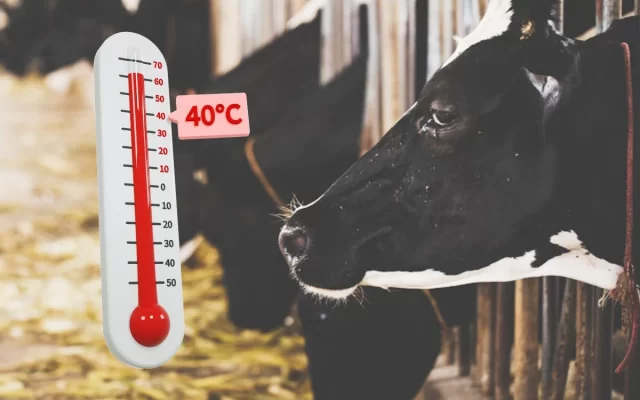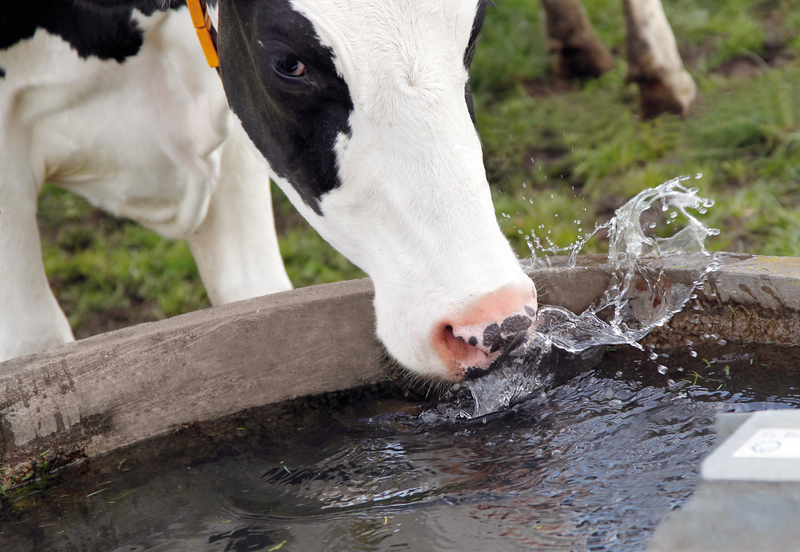
Heat Stress in Dairy Cattle: Causes & Prevention
Heat stress in dairy cattle is a significant challenge, particularly in regions with high temperatures and humidity. As global temperatures rise and climate variability increases, the impact of heat stress on dairy cows has become a growing concern for farmers worldwide. Heat stress can lead to reduced feed intake, lower milk production, poor reproductive performance, and an overall decline in animal health. Therefore, understanding the causes and implementing effective prevention strategies is crucial for maintaining productivity and ensuring animal welfare.
Causes of Heat Stress in Dairy Cattle
Heat stress occurs when a cow’s heat load surpasses its ability to dissipate heat. Several factors contribute to this condition:
- High Ambient Temperature & Humidity: Dairy cattle are highly sensitive to temperatures above 25°C (77°F). When combined with high humidity, their ability to cool down through sweating and respiration becomes less effective.
- Poor Ventilation & Housing Conditions: Inadequate airflow in barns and overcrowded housing can lead to the accumulation of heat, making it difficult for cows to stay cool.
- Direct Sun Exposure: Cows exposed to direct sunlight without adequate shade experience increased body temperature, leading to discomfort and reduced feed intake.
- Metabolic Heat Production: Dairy cows generate substantial heat during digestion and milk production. High-yielding cows are at greater risk as they produce more metabolic heat.
- Limited Water Intake: Insufficient water consumption can exacerbate heat stress, as hydration plays a crucial role in thermoregulation.
Symptoms of Heat Stress in Dairy Cattle
Recognizing early signs of heat stress is essential for timely intervention. Common symptoms include:
- Increased Respiratory Rate & Panting: Cows attempt to dissipate heat through rapid breathing.
- Reduced Feed Intake: Heat-stressed cows eat less, leading to lower milk production.
- Excessive Salivation & Sweating: Increased sweating and drooling indicate thermal discomfort.
- Lethargy & Reduced Activity: Cows tend to stand for prolonged periods to increase heat dissipation.
- Drop in Milk Yield & Quality: Milk production declines due to reduced feed intake and metabolic inefficiencies.
- Fertility Issues: Heat stress negatively impacts estrus expression, conception rates, and embryo survival.
Preventive Strategies to Manage Heat Stress

Preventing heat stress requires a combination of farm management practices, nutritional adjustments, and environmental modifications.
1. Environmental Management
Proper environmental control plays a critical role in reducing heat stress:
- Ventilation & Airflow: Ensure barns have adequate ventilation using fans, ridge vents, or tunnel ventilation systems.
- Shade Management: Provide sufficient shade using natural tree cover, artificial structures, or shade cloth.
- Cooling Systems: Utilize misters, sprinklers, and evaporative cooling pads to lower ambient temperature.
- Mud Pits or Cooling Ponds: Allow cows access to water pools for heat relief in extreme conditions.
2. Nutritional Strategies
Adjusting the diet helps cows cope with heat stress effectively:
- Increased Energy Density: Feed highly digestible fiber and fat sources to compensate for reduced intake.
- Electrolytes & Mineral Supplementation: Supplement sodium, potassium, and bicarbonate to maintain electrolyte balance.
- Higher-Quality Forages: Low-quality roughage generates excess heat during digestion. Use high-quality silage and hay.
- Feed Timing Adjustments: Provide fresh feed during cooler parts of the day, such as early morning and late evening.
3. Hydration Management
Ensuring adequate water intake is essential:
- Clean & Cool Water Supply: Provide unrestricted access to clean and cool drinking water.
- Multiple Watering Points: Install additional water troughs to reduce competition and ensure all cows have access.
- Encourage Water Consumption: Add electrolytes or flavor enhancers to improve water intake.
4. Genetic Selection & Breeding
Breeding heat-resistant dairy breeds can be a long-term solution:
- Crossbreeding Programs: Introduce heat-tolerant breeds like Gir, Sahiwal, or Jersey into high-producing Holstein herds.
- Genetic Selection for Heat Tolerance: Select cows with traits such as shorter hair coats, lighter body color, and better sweating ability.
5. Farm Management Practices
Daily management changes can improve cow comfort:
- Reduce Handling & Transportation: Minimize movement of cattle during peak heat hours.
- Adjust Milking Schedules: Milk cows during cooler times of the day to reduce stress.
- Monitor Body Condition: Maintain optimal body condition to prevent excessive fat deposits that can trap heat.
Economic Impact of Heat Stress
Heat stress not only affects cattle health but also has significant economic implications for dairy farmers:
- Milk Production Losses: Studies suggest heat stress can reduce milk yield by 10-25% during peak summer months.
- Lower Reproductive Efficiency: Increased days open and reduced conception rates lead to prolonged calving intervals.
- Increased Veterinary Costs: Heat-stressed cows are more prone to diseases like mastitis and metabolic disorders.
- Feed Inefficiencies: Reduced feed conversion efficiency results in higher feeding costs per liter of milk produced.
Conclusion
Heat stress is a major concern in dairy farming, impacting both productivity and animal well-being. By implementing a combination of environmental modifications, nutritional adjustments, proper hydration, and genetic improvements, farmers can significantly reduce the effects of heat stress on dairy cattle. Proactive management strategies ensure optimal milk production, improved reproductive performance, and overall better health for dairy herds. Investing in heat stress mitigation techniques is essential for sustainable and profitable dairy farming in the face of rising global temperatures.



















